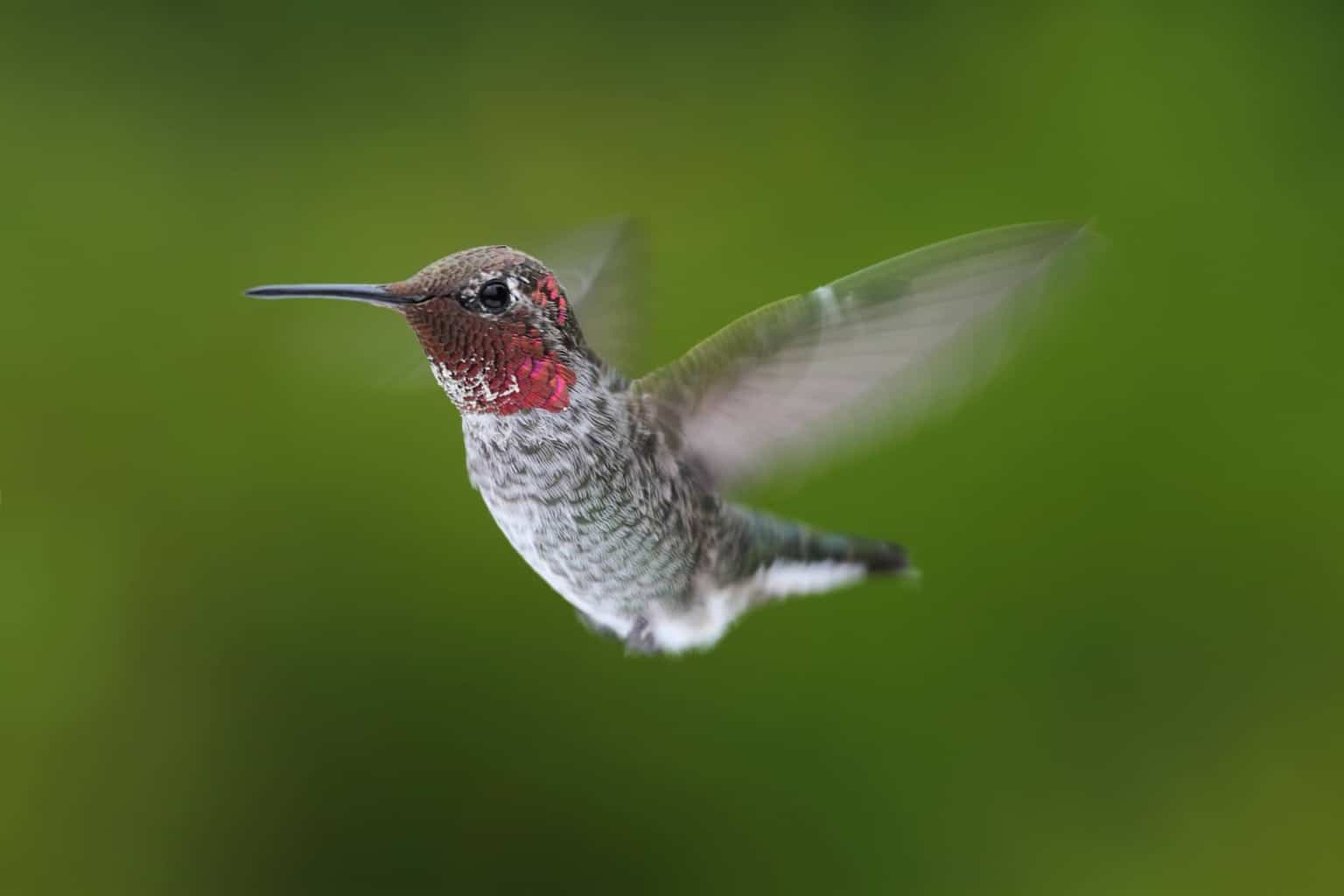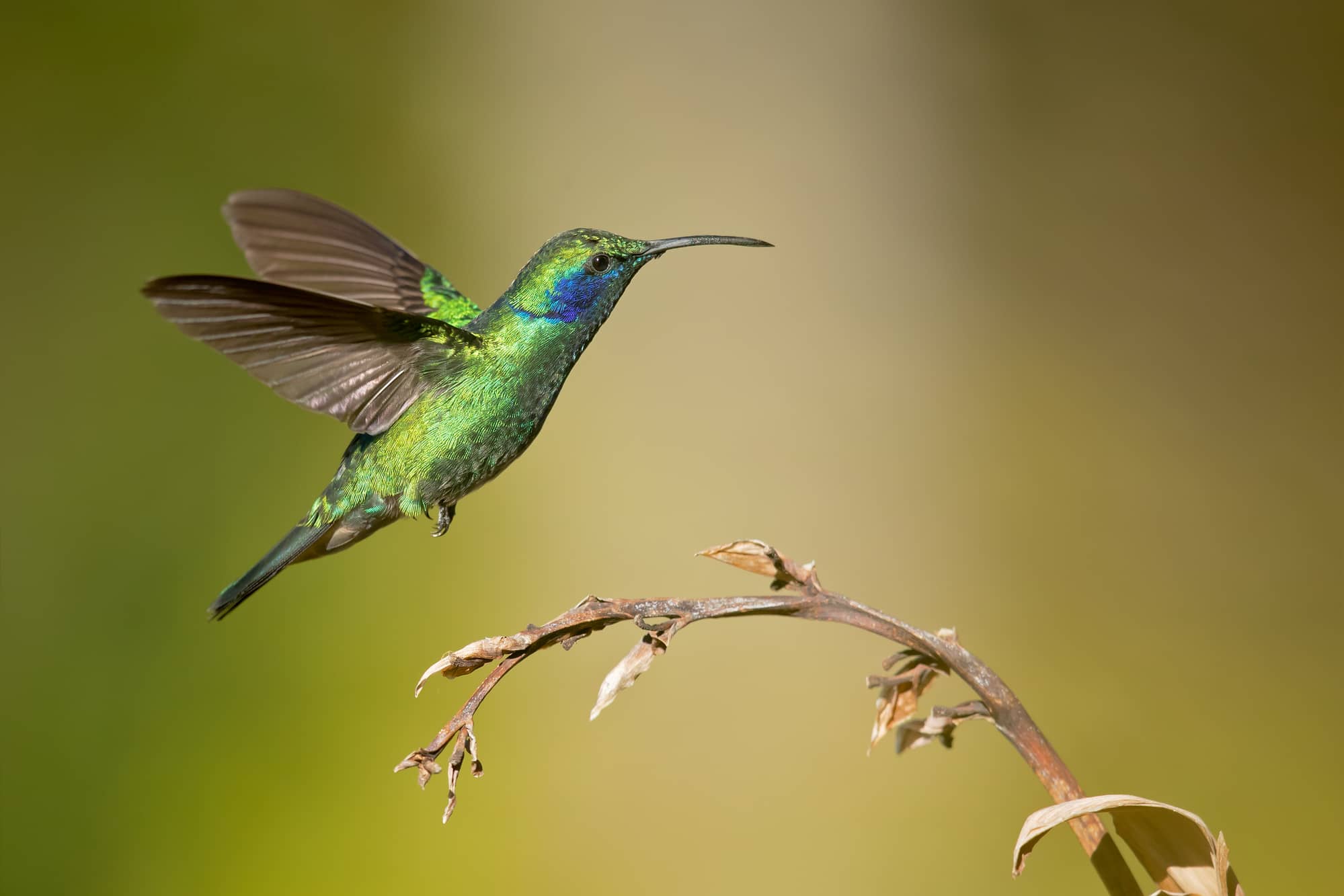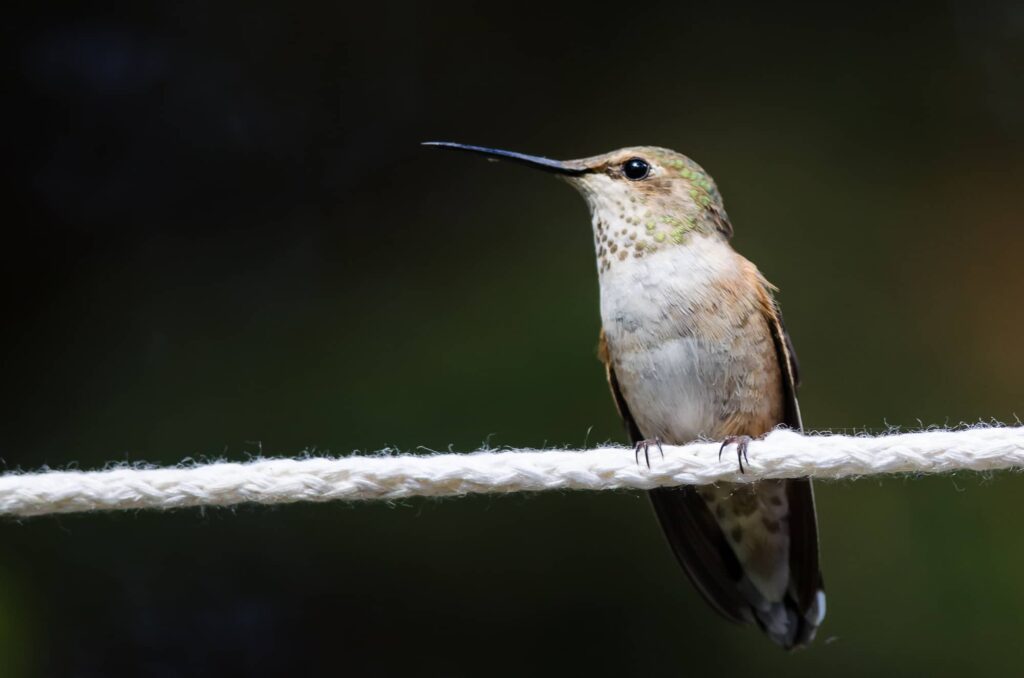Iowa, situated in the Midwestern region of the United States, is bordered by the Big Sioux River and the Missouri River to the west, and the Mississippi River to the east.
Iowa’s vegetation consists of savanna and tallgrass prairie in the upland areas, and flood plains made up of wetlands, dense forests, pothole wetlands, and protected river valleys in the northern prairie areas. Only about 5% of Iowa remains forested, but animal life abounds in the remaining wild places.
Among all the animal life, there are 431 species of birds found in Iowa, putting this state on the must-visit list if you wish to do a bit of bird spotting.
Hummingbirds You Can Find In Iowa
There are five species of Hummingbird that you can see in Iowa. Of these five, one is a regular visitor, one is a casual visitor, and the other three are rare visitors to the state.
Ruby-Throated Hummingbird

- Scientific Name: Archilochus colubris
- Length: 8 – 3.5 inches
- Weight: 071 – 0.212 ounces
- Wingspan: 1 – 4.3 inches
Description:
The adult male and female Ruby-throated Hummingbirds have green-bronze backs, napes, crowns, and two middle tail feathers. Their abdomens are whitish-grey, and their outer tail feathers are dark with a hint of purple.
The adult male is smaller than the female with an iridescent ruby-red throat patch and has a slightly forked tail. The female has a whitish throat patch, and she has rounded tail feathers with white tips.
Additional Information:
Ruby-throated Hummingbirds are native breeders in Iowa. Typically hummingbirds arrive in Iowa in April and leave near the end of September.
Occupying the most extensive breeding grounds and range in North America, Ruby-throated Hummingbirds are the only hummingbird native breeders in eastern North America.
During their migratory flight from their wintering grounds to their breeding grounds, portions of the Ruby-throated Hummingbird population make an impressive 500-mile flight over water across the Gulf of Mexico.
Overall, Ruby-throated Hummingbirds have adapted well to the human environment, and you can often find them visiting a hummingbird feeder and nesting in urban areas.
Rufous Hummingbird

- Scientific Name: Selasphorus Rufus
- Length: 1 inch
- Weight: 071 – 0.176 ounces
- Wingspan: 3 inches
Description:
The adult male Rufous Hummingbird’s primary identifier is his iridescent red-orange throat patch. His back, face, sides, and blacked-tipped tail are all reddish-brown and he has a creamy white abdomen and chest. Some males have a greenish coloration on their backs and/or their crowns.
The Rufous Hummingbird adult female has a greenish-bronze back and a crown with some white. She also has some iridescent orange streaks in her white throat, with a whitish chest and reddish-brown sides.
Additional Information:
The Rufous Hummingbird is a common visitor to Iowa. Although they do not breed there, their visits are usually during their migration flights.
In relation to its size, which is only over 3 inches, the Rufous Hummingbird makes one of the longest migration flights of any other bird in the world, traveling roughly 3,900 miles from Alaska to Mexico!
The Rufous Hummingbird is also the only hummingbird that breeds as far north as southeastern Alaska. This western hummingbird is also the most frequent visitor to the east.
The Rufous Hummingbird is notably relatively fearless, chasing away other birds or rodents from their feeding territories.
Anna’s Hummingbird

- Scientific Name: Calypte anna
- Length: 9 – 4.3 inches
- Weight: 1 – 0.2 ounces
- Wingspan: 7 inches
Description:
The adult male Anna’s Hummingbird is primarily identified by his distinctive reddish-colored throat patch and forehead.
The feathers that project down the sides of his neck are elongated, his sides and backs are a dark metallic green-bronze, and his tummy is grey with mottled green.
The adult female’s upper plumage is green, with a tummy that is either greyish white or brownish grey, often with some green spots. She has a grey throat with some red spotting which intensifies towards the middle of her throat, forming a small irregular patch.
Additional Information:
Anna’s Hummingbird is a rare visitor to Iowa and a native to North America’s western coastal regions tending to be a permanent resident in their range.
These hummingbirds have the most northern year-round range of any other hummingbird, with records showing them in Alaska, and others taking up residency in the Pacific Northwest. If temperatures drop below a certain degree, this type of hummingbird can enter a state of torpor, slowing its heart and metabolic rate.
Known for its territorial behavior, the male Anna’s Hummingbird will make elaborate diving displays targeted at other birds and even in rare cases at humans. His tail produces high-pitched popping sounds at the bottom of his dives.
Broad-Billed Hummingbird

- Scientific Name: Cynanthus latirostris
- Length: 1 – 3.9 inches
- Weight: 1 – 0.14 ounces
- Wingspan: 1 inch
Description:
The adult male Broad-billed Hummingbird has a deep blue throat patch and a glossy green chest and back. He has a slender, straight, red beak with a black tip, and his tail is forked and dark above with white underneath.
The adult female Broad-billed Hummingbird is less colorful than her male counterpart; she has a white stripe over her eyes, a pale belly, and white-tipped tail feathers.
Additional Information:
Broad-billed Hummingbirds are rare visitors to Iowa, with only a handful on record. They mainly breed in the southwestern United States, occasionally traveling to Louisiana and Texas.
These hummingbirds typically nest along streams in canyons, preferring to nest in elevations below 6,500 feet. Although, they will forage in mountain meadows and canyons as high as 9,800 feet to get to the best flowers.
Broad-billed Hummingbirds feed on nectar and insects, and they are also known to be regular visitors to sugar-water hummingbird feeders. The Broad-billed Hummingbird extends its long tongue to feed on the flower’s nectar.
Green Violetear Hummingbird

- Scientific Name: Colibri thalassinus
- Length: 25 – 4.5 inches
- Weight: 17 – 0.20 ounces
- Wingspan: 72 inches
Description:
The adult male Green Violetear Hummingbird has a glittering green back, chest, and throat, turning into bronze on his rump and upper-tail feathers.
On the sides of his neck, he has an ear patch which is a glittering violet and his tail is slightly notched and square, with a broad dark blue band situated at the end.
The adult female Green Violetear Hummingbird has a similar coloration, although slightly duller with a narrower violet band on her chin. She is also smaller in size than her male counterpart.
Additional Information:
The Green Violetear Hummingbird is a rare visitor to Iowa, as it is primarily a Central America and Mexico resident. However, observations show some seasonal movements, and records show that they have visited as far north as Canada.
This hummingbird species is also commonly known as the Mexican Violetear Hummingbird and prefers to inhabit scrubs and trees in the semi-open upland country. They prefer to live in more humid environments.
Nectar from various brightly colored, small scented flowers is the Green Violetear’s primary food source, though the odd spider and small insect are also food sources for these hummingbirds, providing them with essential protein.
Conclusion
Although there are not many regular hummingbird visitors to Iowa, you should spot their native breeder during breeding months.
Don’t let this disappoint you, though, because Iowa has many other species of bird for you to see! The following list can show you which other beautiful birds there are to see in Iowa.

